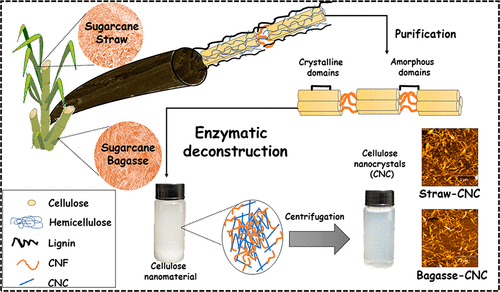当前位置:
X-MOL 学术
›
ACS Sustain. Chem. Eng.
›
论文详情
Our official English website, www.x-mol.net, welcomes your
feedback! (Note: you will need to create a separate account there.)
Enzymatic Deconstruction of Sugarcane Bagasse and Straw to Obtain Cellulose Nanomaterials
ACS Sustainable Chemistry & Engineering ( IF 7.1 ) Pub Date : 2020-01-24 , DOI: 10.1021/acssuschemeng.9b06806 Jéssica de Aguiar 1, 2 , Thalita Jessika Bondancia 1, 3 , Pedro Ivo C. Claro 1, 2 , Luiz Henrique C. Mattoso 1, 2 , Cristiane S. Farinas 1, 3 , José Manoel Marconcini 1, 2
ACS Sustainable Chemistry & Engineering ( IF 7.1 ) Pub Date : 2020-01-24 , DOI: 10.1021/acssuschemeng.9b06806 Jéssica de Aguiar 1, 2 , Thalita Jessika Bondancia 1, 3 , Pedro Ivo C. Claro 1, 2 , Luiz Henrique C. Mattoso 1, 2 , Cristiane S. Farinas 1, 3 , José Manoel Marconcini 1, 2
Affiliation

|
The application of green process engineering strategies to obtain high-value, eco-friendly, and biodegradable materials from residual lignocellulosic biomass can contribute to the sustainability of future biorefineries. Here, we investigated the potential of sugarcane bagasse and straw as lignocellulosic biomass feedstocks to obtain nanocellulose, using the enzymatic hydrolysis route as a platform. The fibers were submitted to a purification process followed by enzymatic hydrolysis with a commercial enzyme cocktail. The cellulose nanomaterials obtained from both fibers (sugarcane bagasse and straw) presented a high crystallinity index (∼70%) and thermal stability (degradation onset temperatures higher than 300 °C). After the enzymatic hydrolysis, a centrifugation step was used to separate the cellulose nanocrystals (CNC) present in the nanocellulose samples. The increase of the duration of enzymatic hydrolysis resulted in an increase of the CNC content and decreases in the diameter and length of the CNC. These findings indicated the potential of using the enzymatic route as a platform to obtain nanocellulose as a value-added bioproduct from both sugarcane bagasse and straw. In addition to being eco-friendly, this process also releases a stream rich in soluble sugars that can be used to produce ethanol or other biobased products, within the biorefinery concept.
中文翻译:

酶解甘蔗渣和秸秆以获得纤维素纳米材料
应用绿色工艺工程学策略从残留的木质纤维素生物质中获得高价值,环保和可生物降解的材料,可有助于未来生物精炼厂的可持续性。在这里,我们利用酶促水解途径作为平台,研究了甘蔗渣和秸秆作为木质纤维素生物质原料的潜力,从而获得了纳米纤维素。将纤维进行纯化过程,然后用市售酶混合物进行酶促水解。从两种纤维(甘蔗渣和稻草)获得的纤维素纳米材料均具有较高的结晶度指数(约70%)和热稳定性(降解起始温度高于300°C)。酶水解后 离心步骤用于分离存在于纳米纤维素样品中的纤维素纳米晶体(CNC)。酶促水解持续时间的增加导致CNC含量的增加,以及CNC直径和长度的减小。这些发现表明使用酶促途径作为平台从甘蔗渣和稻草中获得纳米纤维素作为增值生物产品的潜力。除了对环境友好外,此过程还释放出富含可溶性糖的物流,该物流可用于在生物精炼概念范围内生产乙醇或其他生物基产品。这些发现表明使用酶促途径作为平台从甘蔗渣和稻草中获得纳米纤维素作为增值生物产品的潜力。除了对环境友好外,此过程还释放出富含可溶性糖的物流,该物流可用于在生物精炼概念范围内生产乙醇或其他生物基产品。这些发现表明使用酶促途径作为平台从甘蔗渣和稻草中获得纳米纤维素作为增值生物产品的潜力。除了对环境友好外,此过程还释放出富含可溶性糖的物流,该物流可用于在生物精炼概念范围内生产乙醇或其他生物基产品。
更新日期:2020-01-26
中文翻译:

酶解甘蔗渣和秸秆以获得纤维素纳米材料
应用绿色工艺工程学策略从残留的木质纤维素生物质中获得高价值,环保和可生物降解的材料,可有助于未来生物精炼厂的可持续性。在这里,我们利用酶促水解途径作为平台,研究了甘蔗渣和秸秆作为木质纤维素生物质原料的潜力,从而获得了纳米纤维素。将纤维进行纯化过程,然后用市售酶混合物进行酶促水解。从两种纤维(甘蔗渣和稻草)获得的纤维素纳米材料均具有较高的结晶度指数(约70%)和热稳定性(降解起始温度高于300°C)。酶水解后 离心步骤用于分离存在于纳米纤维素样品中的纤维素纳米晶体(CNC)。酶促水解持续时间的增加导致CNC含量的增加,以及CNC直径和长度的减小。这些发现表明使用酶促途径作为平台从甘蔗渣和稻草中获得纳米纤维素作为增值生物产品的潜力。除了对环境友好外,此过程还释放出富含可溶性糖的物流,该物流可用于在生物精炼概念范围内生产乙醇或其他生物基产品。这些发现表明使用酶促途径作为平台从甘蔗渣和稻草中获得纳米纤维素作为增值生物产品的潜力。除了对环境友好外,此过程还释放出富含可溶性糖的物流,该物流可用于在生物精炼概念范围内生产乙醇或其他生物基产品。这些发现表明使用酶促途径作为平台从甘蔗渣和稻草中获得纳米纤维素作为增值生物产品的潜力。除了对环境友好外,此过程还释放出富含可溶性糖的物流,该物流可用于在生物精炼概念范围内生产乙醇或其他生物基产品。











































 京公网安备 11010802027423号
京公网安备 11010802027423号